Can a Triple-Decker be Retrofitted for Geothermal Heating and Cooling?
. Posted in News - 0 Comments
By Eric Weld, MassLandlords, Inc.
The triple-decker is a Massachusetts architectural icon and, to many, a beloved aspect of New England history and urban landscape. But can these symbols of Massachusetts cultural history, most of which were built 100 years ago or more, be updated for today’s and tomorrow’s energy efficiency technologies?
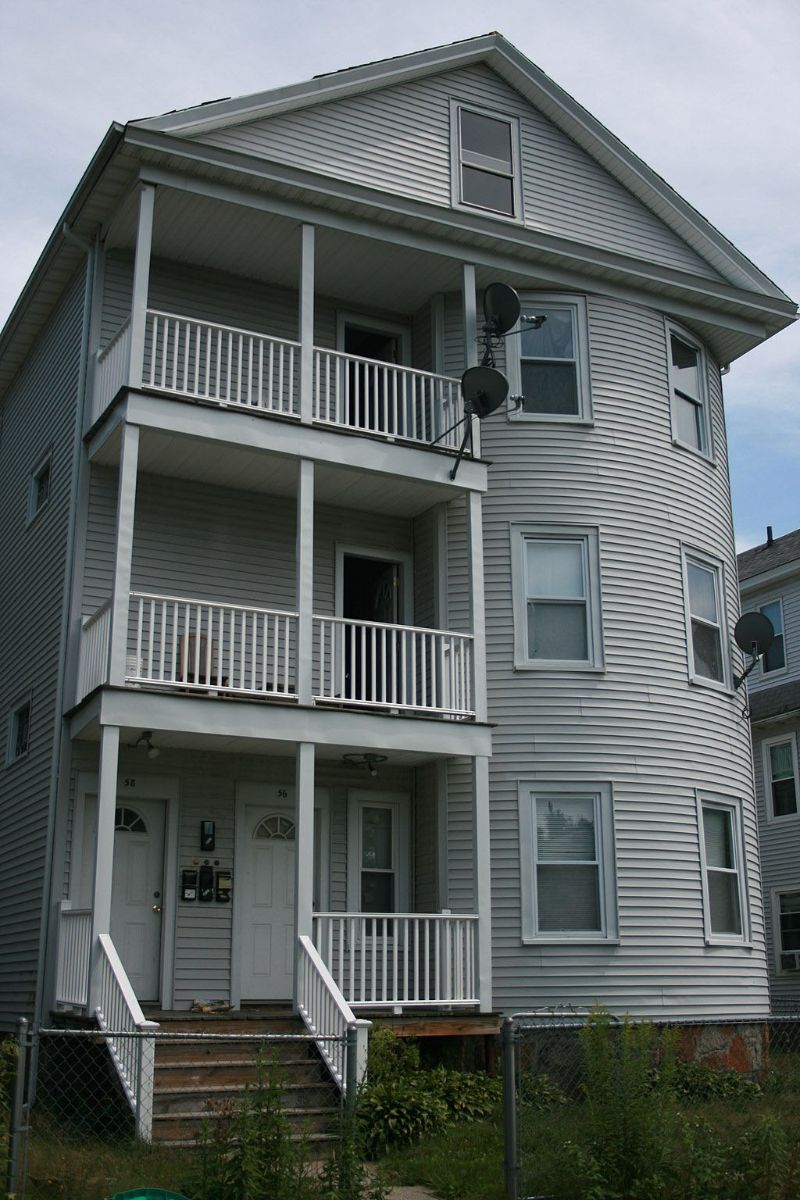
There are more than 25,000 triple-deckers like this one across Massachusetts. Nearly every one of them will need to be converted away from fossil fuel-burning energy systems in coming years. Image: CC BY-SA pvmoutside (Wikimedia commons).
Specifically, is it possible to retrofit a triple-decker to accommodate geothermal energy, the most efficient method available for heating and cooling a home? And if it is possible, is it economically feasible?
These are questions looming on the near horizon as Massachusetts aspires to achieve net neutrality – zero fossil fuel emissions – by 2050.
There are, after all, tens of thousands of triple-deckers – also known as three-deckers, triplexes or “3Ds” – still standing throughout the state. Boston alone is home to some 15,000 of them. In Worcester, which may have hosted the first triple-decker ever built (by Francis Gallagher), around 4,000 remain. Another 4,000 are in Fall River.
Triple-deckers are not going away. In fact, they are experiencing a sort of renaissance, being bought up by local developers, renovated and glossed into attractive rentals and condos.
But most triple-deckers are old, some are drafty, and many use outdated, fossil fuel-burning systems for heating, cooling, cooking and heating water. Tens of thousands of these multifamily residences will need investments of time and attention in order to bring them in line with the state’s energy efficiency goals.
If a retrofit for geothermal energy is possible and affordable, it could answer a list of concerns facing the state and its push to reduce the carbon footprint – not to mention save collective millions of dollars in energy costs for owners of these residences.
Yes, in Theory
The short answer is yes, it is possible, on paper, to retrofit many three-deckers for geothermal energy. Many things are possible if you have the budget to make them happen.
But for many triple-deckers that haven’t been upgraded in decades, it would require several steps, each with its commensurate expense.
First of all, it wouldn’t make any sense to consider energy efficiency system upgrades without first tending to the building’s envelope, notes Timothy Redmond, owner of Redmond HVAC, a Worcester contractor that mostly installs geothermal energy systems in new builds.
“One of the best things you can do is upgrade the envelope of the building to cut down on the amount of energy you’re using,” he said. “Three-families are not going to save money if you don’t put in air sealing, insulation, new windows and doors, etcetera.”
Then, for many of these century-old homes, there are issues with removing old steam boilers and asbestos-covered pipes, then installing air handlers and duct work throughout the building. And that’s all before you get to the biggest ticket item: excavating the lot to install underground piping.
As with any large project on an investment property, it’s a calculation of how much capital headroom you have to invest up front and how long it will take to realize return on your investment. Triple-deckers are large buildings on a residential scale, typically somewhere around 3,500 square feet of living space. They will require a heating and cooling system larger than most single-family homes, at a higher cost.
“Most triple-deckers are very difficult to retrofit,” notes Redmond. “Every part of doing a three-family retrofit would be difficult. There’s barely any room when it comes to a three-family neighborhood. They’re always very close together. There’s no place to drill, you’d have to go under the driveway in many cases. Then there’s the matter of, you got big rigs coming in, large water trucks, traffic problems, excess water from the drilling process.”
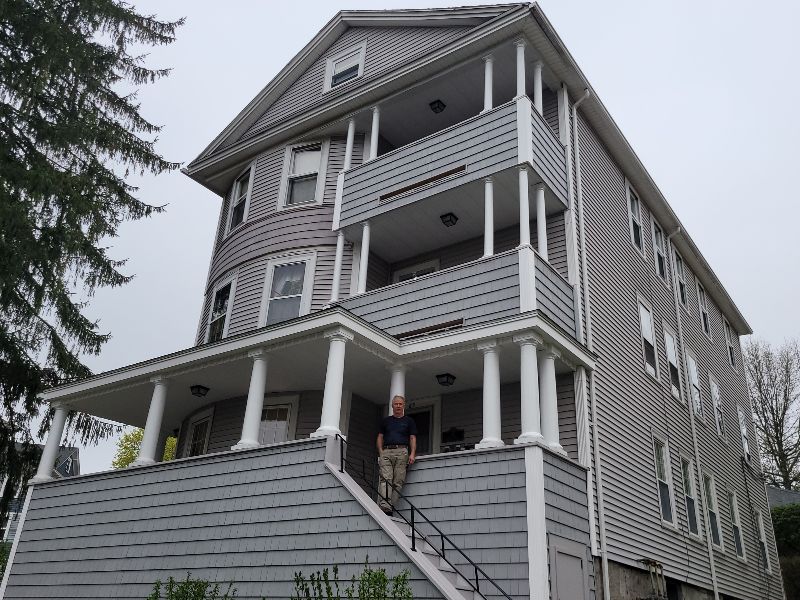
Phil Arsenault, pictured, aims to convert this Worcester triple-decker, which he bought in 2012, to geothermal energy. According to anecdotal evidence, he would be among the first in the state to complete a geothermal conversion for heating and cooling. Image: courtesy of Phil Arsenault.
Investment in the Future
Still, despite Redmond’s skepticism of triple-decker geothermal retrofits, these homes remain part of our state’s cultural, architectural and energy profile and will have to somehow be updated for non-fossil fuel energy production.
Phil Arsenault, an electrician in Worcester, owns two triple-deckers, one of which he purchased in 2012. He would like to, and is determined to, convert his newest three-decker to geothermal energy and has made steps toward doing so. He installed solar panels in 2014 and is upgrading some old knob-and-tube wiring, among other projects.
Arsenault consulted with Redmond and a few other geothermal contractors, who told him retrofitting for geothermal is simply not cost-effective. In fact, finding a geothermal contractor who will consider a three-decker retrofit has been one of his biggest challenges.
“Heat, fuel is all going up,” he said, “it’s not going to come down, the cost of heating a house is going to keep going up. If I put in geothermal, I think it’s a wise investment. It’s an investment for the future.”
Arsenault admits that the amount of capital left over for improvements is very limited after outlaying the high initial costs of purchasing a property in Massachusetts. His conversion to geothermal may have to be carried out in increments, he said – first buttoning up the home’s envelope, updating wiring, then upgrading to a high-efficiency gas furnace before ultimately changing over to geothermal.
“I don’t know how much it’s going to cost, could be a lot of money. But I’d love to be able to do this and make it happen,” he says of retrofitting his triple-decker for geothermal. “Just to be the showcase. I’ve always thought about, ‘What are we passing on to our kids?’”
Arsenault’s luck in finding a geothermal contractor may have recently changed. He very recently received an estimate for geothermal retrofit of his triple-decker for $75,000 from Dandelion Energy, a regional geothermal contractor serving customers in Massachusetts, New York and Connecticut. Arsenault would be responsible for installing heating systems. Dandelion will conduct an assessment for his project soon, he said.
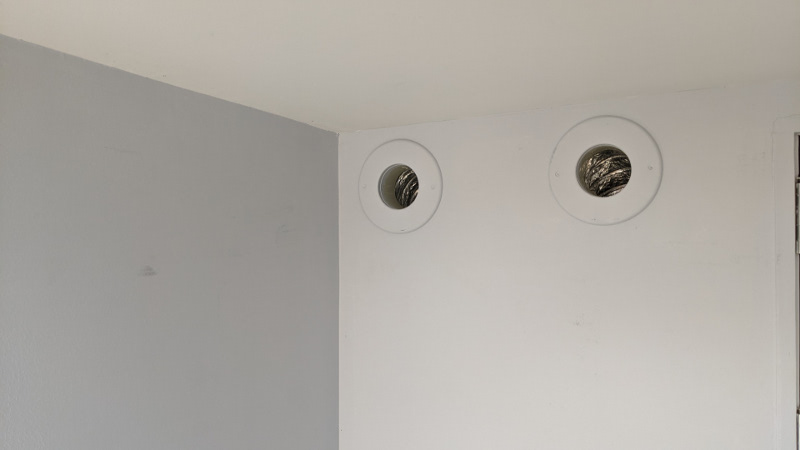
High-velocity mini-ducts up close. Each opening is approximately two-and-a-half inches in diameter. Licensed CC BY-SA 4.0 MassLandlords, Inc.
Geothermal the More Efficient Choice
If Arsenault were able to successfully retrofit his Worcester triple-decker, he would indeed be a sort of pioneer. Because of the prohibitive upfront cost of geothermal, it’s a prospect that has not yet caught hold for three-decker owners. (If you know of a three-decker owner who has or is in the process of retrofitting for geothermal, we’d like to know about it. Email us at hello@masslandlords.net.)
Just the cost of laying a loop of underground piping for a system large enough to suitably heat and cool a three-decker could cost north of $50,000. And that depends on ample lot space in which to plant that pipe network. When they were built, triple-deckers’ urban housing design sought to maximize lots’ living space for families. These buildings usually occupy most of the lot on which they sit. The result: not a lot of yard space to accommodate a geothermal loop, which could require a half-acre or more of unbuilt lot.
Of course, geothermal energy isn’t the only choice when upgrading a multifamily for electric energy. Electric air source heat pumps (ASHPs) are, so far, the more popular option for three-family upgrades. It’s easy to understand why.
Air source heat pumps are installed above ground. There’s no need for excavation and a large network of underground piping, or a lot in which to plant it. Air source heat pumps can also operate via a ductless system, using mini-split units to disburse and collect warm and cool air as the season demands.
But the preference for ASHPs may soon change thanks to innovation of small-duct, high-velocity air flow systems. These efficient duct systems can work in conjunction with existing furnaces or heat pumps, including geothermal. The duct units are comparatively much smaller than conventional sheet metal ducts – about 2 or 3 inches in interior diameter – and utilize several distribution points for more consistent air conditioning.
It’s also possible for geothermal systems to work in concert with existing forced hot-water baseboards (for heating only, not cooling) via a water-to-water heat pump, eliminating the need for ductwork altogether.
As for efficiency, geothermal systems are the gold standard, significantly more efficient than air source heat pumps because the energy extracted from underground comes at a consistent 50-65 degrees Fahrenheit regardless of what is happening on the surface. It doesn’t require much electrical energy to extract this heat for interior exchange. By contrast, air source heat pumps are least efficient when most needed. They expend much more electricity than ground source to extract useable heat from freezing outside air.
One System, Many Users
Another technological innovation in the works may also help bring geothermal energy to the masses someday.
A pilot program coordinated by Eversource is installing a neighborhood-wide geothermal system of pipes, wells and air pumps in the Concord Street area of Framingham. The pilot is offering customers in the neighborhood to convert to geothermal for a trial duration of two heating and cooling seasons.
If this pilot is successful, it’s possible to imagine more such systems in which an entire region of homes and businesses use a common geothermal loop for their heating and cooling needs, and savings for all.
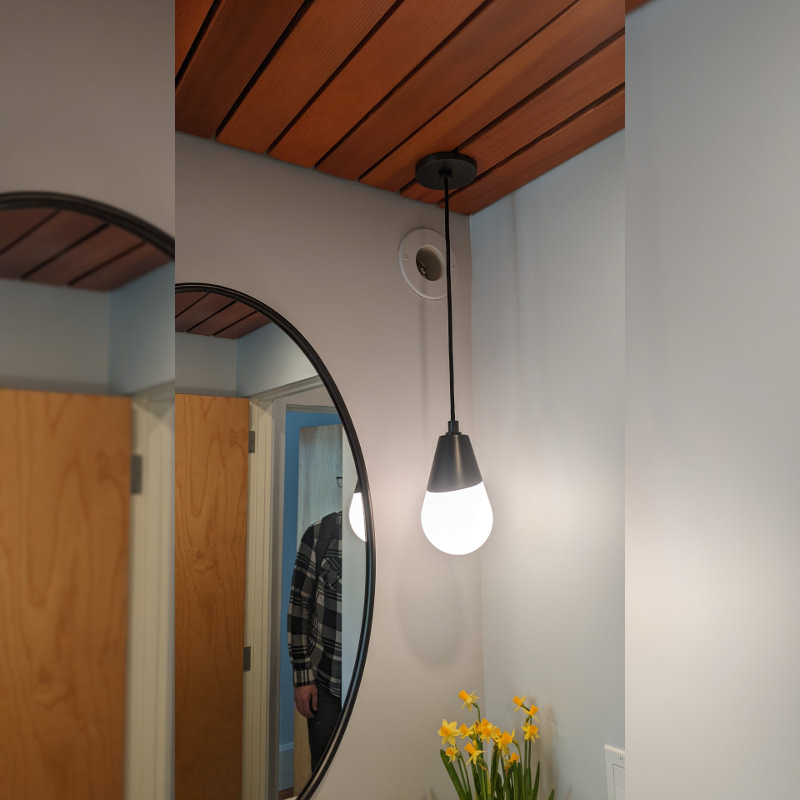
A single high-velocity mini-duct heats and cools a bathroom after running through a thin wall where the mirror and sink are located. Licensed CC BY-SA 4.0 MassLandlords, Inc.
Triple-Decker Retrofits Underway
The cost of geothermal conversion notwithstanding, the need for triple-decker energy efficient solutions is on the radar screen of those tasked with navigating future consumption and emissions.
The Massachusetts Clean Energy Center (MassCEC), a state agency focused on growing the clean energy industry, coordinated the Triple Decker Design Challenge in 2020. The challenge was a contest inviting designers, architects, engineers and energy retrofit technicians to submit their best ideas for how to upgrade these residential buildings for electric energy efficiency.
The contest generated 14 innovative designs, with winners receiving cash prizes. As a follow up to the contest, MassCEC launched the Triple Decker Retrofit Pilot, which offers technical and financial support for qualifying triple-decker owners to retrofit for electric heating and cooling systems, using plans informed by the contest.
But notably, among all the contest winners, the one with the lowest price tag (called the TDC Retrofit Toolkit by Zephyr) would cost $152,149. It’s hard to speculate on geothermal retrofitting costs for three-deckers because of the dearth of them. But if we estimate underground pipe drilling costs at $70,000; ground source heat pumps and mini-ducts at the full air source cost of $12,000 per floor, or $36,000 total; and insulation at $30,000, it still leaves room for other miscellaneous costs. This seems to put geothermal on par with the cheapest winning Triple Decker Design Challenge entry, which advocates for air source heat pumps. If so, geothermal should be the dominant choice for its much lower long-term costs and longer system life.
Also, consider Arsenault’s rough installation estimate from Dandelion for $75,000. Even adding in heating systems and other miscellaneous costs keeps that geothermal retrofit total competitive with (or even lower than) the MassCEC contest winners’ designs.
Mass Save Loans and Rebates for Geothermal
If we hope to enable triple-decker owners to convert en masse for geothermal energy, it will require more public money, avers Redmond, in order to justify the investment.
Mass Save offers rebates for ground source (geothermal) heat pumps of up to $15,000 for a qualifying whole-home system. Rebates are also available for partial home systems. Mass Save also offers 0% HEAT loans for energy efficiency upgrades, including installation of ground source heat pumps.
As Phil Arsenault points out, with housing prices being what they are in Massachusetts – especially the eastern part of the state where most the three-deckers are – the amount of capital left over for upgrades after purchase is limited.
But suppose an owner like Arsenault did take the plunge and fully invest in a geothermal retrofit for his triple-decker. How best to make your money back on that investment so that it makes fiscal sense? Part of the equation would almost certainly have to include rent levels that reflect the value of utilities included. And why not? Tenants will save substantially on heating and cooling costs in their homes using geothermal energy, and owners can realize a return on the investment.
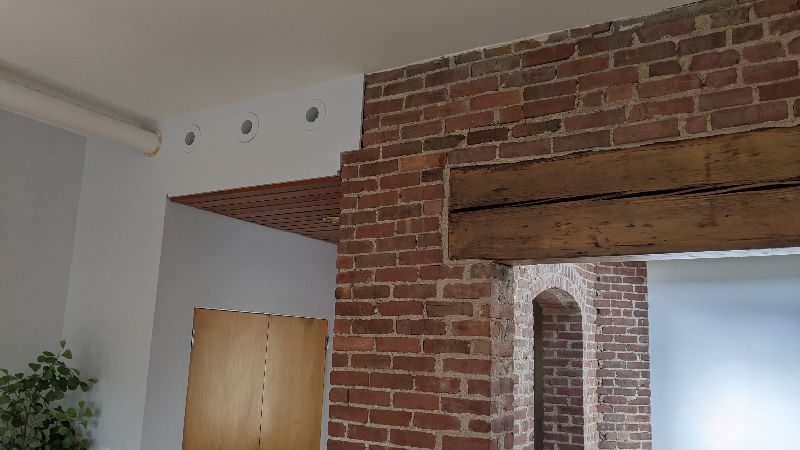
Three high-velocity mini-ducts feed the living room in this mill building renovation. The mini-ducts allowed recessed lighting to be used directly behind them. Licensed CC BY-SA 4.0 MassLandlords, Inc.
Future Inevitability
The affordability of retrofitting three-deckers for geothermal may simply be a question of perspective. Some geothermal contractors see an outdated triple-decker and only consider conventional solutions and costs. Future-oriented owners like Arsenault see possibility.
And geothermal technology is moving fast. Single-family homes are being retrofitted by the thousands. Across the U.S., 50,000 geothermal heat pumps are being installed every year. Its time may have arrived for innovative thinkers.
We at MassLandlords would like to hear about your experience or thoughts on geothermal and other emerging technologies and their possibilities for the state’s thousands of triple-deckers and other rentals.
Have you installed high speed miniducts? Would you recommend them?
Are you a duct installer or geothermal contractor? What are your thoughts on retrofitting triple-deckers?
We seek information that can help us bring the costs down of retrofitting our own and others’ triple-deckers.
Let us know your thoughts at hello@masslandlords.net.




